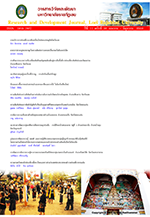แนวคิดทางทฤษฎีและเรื่องที่ปรากฏ: การเลิกจ้างเมื่อค่าจ้างสูง
Keywords:
การเลิกจ้าง, การจ้างงานตลอดชีวิต, บริษัทต่างชาติ, มูลค่าเพิ่มของแรงงาน, dismissal, lifetime employment, foreign firm, Value of Marginal Product of Labour (VMPL)Abstract
บทความทางวิชาการเรื่องนี้อาศัยข้อมูลส่วนหนึ่งจากรายงานวิจัยที่ผู้เขียนได้ศึกษาเสร็จสิ้นแล้ว โดยมุ่งแสดงความจริงเฉพาะเรื่องการเลิกจ้างเมื่อค่าจ้างสูง ในนิคมอุตสาหกรรมอิสเทิร์น ซีบอร์ด จังหวัดระยอง ข้อมูลดังกล่าวนำมาวิเคราะห์ด้วยสถิติพรรณนา และใช้ทฤษฎีเศรษฐศาสตร์แรงงานอธิบายปรากฏการณ์การจ้างแรงงานค่าจ้างสูงกับการจ้างแรงงานค่าจ้างต่ำในสภาพการทางานที่คล้ายกัน และผลที่ปรากฏคือ แรงงานค่าจ้างสูงมักถูกเลิกจ้างเมื่อค่าจ้างสูงถึงระดับหนึ่ง ส่วนแรงงานค่าจ้างต่ำจะยังคงทำงานได้ต่อไปยาวนานกว่า แนวคิดทางทฤษฎีเศรษฐศาสตร์ที่นำมาอธิบายได้อย่างมีเหตุผลมากที่สุด คือ ทฤษฎีความสัมพันธ์ระหว่างค่าจ้าง (Wage) กับความสามารถที่แรงงานจะทำรายได้ให้นายจ้าง (VMPL) ในทางปฏิบัติ เมื่อนายจ้างคิดหรือคาดเดาว่าลูกจ้างคนใดหรือกลุ่มใดมีสภาพ Wage > VMPLก็จะเลิกจ้างหน่วยธุรกิจที่ให้ค่าจ้างสูงและมักเลิกจ้างแรงงานเมื่อค่าจ้างสูงมากถึงระดับหนึ่ง คือ หน่วยธุรกิจที่คนอเมริกัน-ยุโรปเป็นเจ้าของ ส่วนบริษัทที่คนเอเชียเป็นเจ้าของจะให้ค่าจ้างต่ำกว่า แต่การเลิกจ้างเมื่อค่าจ้างสูง มีปรากฏน้อย
The oretical concept and the evidence: The dismissal of employees at higher wage
This paper used a part of data from my complete research report for explaining the phenomenon of the high wage dismissal in factories at Eastern Seaboard Industrial Estate, Rayong Province. The descriptive statistical method was a tool for analysis the data together with labour economics theory to explain the phenomena of higher and lower wage employment of similar work conditions. The evidence was the higher wage employees were liable to be dismissed when they received a level of high wage while lower wage employees could maintain their work. The most suitable economics theory for explaining the phenomenon was the relation between wage and marginal productivity of labour (W vs VMPL). In practice, employers never calculate an employee’s VMPL but they tried to figure out whoever were in the case of Wage > VMPL would be dismissed. In practice the employer merely just whether one’s performance was worth his or her wage; they would dismiss an employee or a group of employees whose performance was not worth that wage.
The evidence showed that American or European firms gave higher wage than that of Asian firms but they would dismiss their employees when those employees reached a certain high wage level while the Asian firms rarely did so.
Downloads
How to Cite
Issue
Section
License
ข้อความที่ปรากฎในวารสารฉบับนี้เป็นความคิดเห็นของผู้เขียนแต่ละท่าน สถาบันวิจัยและพัฒนา มหาวิทยาลัยราชภัฏเลย และกองบรรณาธิการ ไม่จำเป็นต้องเห็นด้วยและไม่มีส่วนรับผิดชอบใดๆ
สถาบันวิจัยและพัฒนา มหาวิทยาลัยราชภัฏเลย ขอให้ผู้อ่านอ้างอิงในกรณีที่ท่านคัดลอกเนื้อหาบทความในวารสารฉบับนี้






